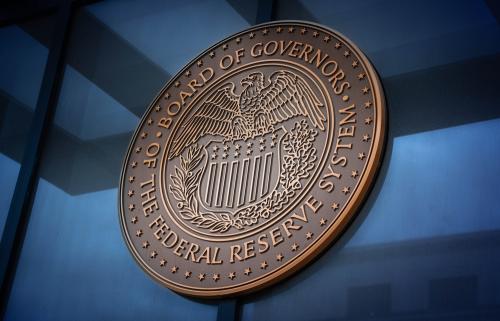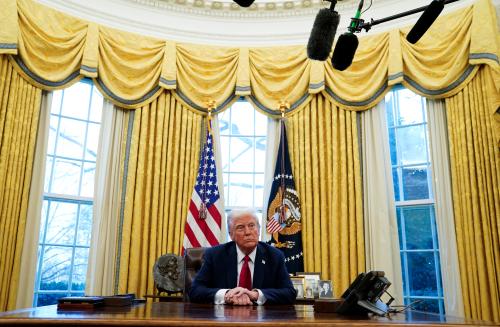The president of the United States can, in theory, launch nuclear war by personal decision—without any checks or balances. Whether we really think any of the candidates for president in 2016 would cavalierly start a nuclear war, the bombastic and bizarre character of much of this year’s electoral debate should make us take this question seriously. Someday, the United States really could have a mentally ill president who chose to do the unthinkable. The odds are low, but we should seek to make them even lower, given the stakes at hand. Because it looks like humankind will be stuck with the nuclear bomb for many decades (if not centuries) to come, moreover, the solution to this problem cannot be simply to get rid of all existing nuclear arsenals. We need a more immediate answer.
To be sure, a president is required by the War Powers Act of 1973 to seek congressional approval for any military action within 60 days of its inception. But most presidents consider that act unconstitutional. In any event, a nuclear war could easily devastate the planet within just days or hours—long before the 60-day stipulation would be binding. Even if a president had obtained congressional approval for a war that began using only conventional weapons, no provisions of the War Powers Act would require subsequent congressional action prior to nuclear escalation.
In short: A president could push the button all by himself or herself, legally- and constitutionally-speaking. Physically, military personnel would need to carry out the strike of course. They could choose not to, perhaps at the instruction of the secretary of defense or the four-star officer leading Strategic Command—who together constitute the chain of command between the president and the trigger-pullers. But any military officer ignoring a presidential order would be in open insubordination, subject to dismissal and court martial.
Some thoughts to keep you up at night
Can we really trust the future of the human race to the continued steady decisionmaking of single individuals who have the power to kill tens or hundreds of millions, based on a single unchallenged edict? The Donald Trump candidacy helps illustrate the problem. Even if his rhetoric is mostly harmless bombast, we cannot be so sure. Nor can we know how a future president might behave if he or she becomes mentally ill while president. Indeed, we have seen forewarnings in other nuclear-armed states: even leaving aside the Kims in North Korea, examples spanning from Boris Yeltsin’s frequent drunkenness to Vladimir Putin’s petulance underscore that this is far from just a theoretical concern.
Can we really trust the future of the human race to the continued steady decisionmaking of single individuals who have the power to kill tens or hundreds of millions, based on a single unchallenged edict?
For decades, nuclear strategists like Bruce Blair and Scott Sagan have written about the dangers of nuclear forces that are constantly on high, hair-trigger alert. Their warnings have focused largely on scenarios in which inadvertent, accidental, or unauthorized nuclear war could occur due to: technical malfunctions, superpower militaries fighting conventional battles against each other, or Strangelovian and treasonous military officers situated at certain key locations in the nuclear chain of command.
To their wise warnings I would add another: the possibility of completely intentional nuclear war initiated by a psychotic, schizophrenic, or otherwise unbalanced leader. Again, for all his barbs and insults and affected anger, Trump is likely not such a person. But his candidacy is enough at least to raise the salience of the question.
Walking back from hair trigger
Thus, the United States needs additional checks and balances on how it would ever consider the use of nuclear weapons in war. Once we figure it out, moreover, we must go beyond reducing the chances of our own president making a horrible mistake—we must share the model with other nations.
To be sure, the balance of powers needs to be carefully construed. It would also need to be nimble. In certain crisis situations, a decision on the use of nuclear weapons might have to be made fast. Indeed, Cold War nuclear practices anticipated the possibility of the United States deciding to launch an all-out nuclear strike on the Soviet Union within about 20 minutes in the most extreme circumstance. Many thought deterrence theory would require the capacity to “launch on warning”—but before a single Soviet warhead had detonated on American soil.
Whether rightly or not, vestiges of these kinds of scenarios still influence Russian and American war plans. But there are other, more realistic and more understandable contingencies to consider as well. What if we somehow wind up in a future Korean war? North Korea’s suspected arsenal of 10 or more bombs would likely constitute an acute threat to Seoul, Tokyo, allied troops fighting North Korea’s army, or even American territory. We could address such a threat with air and missile defense, preemption against any missiles we saw being prepared for launch, and preventive attacks on suspected nuclear warhead storage facilities. But what if conventional weapons didn’t suffice to protect South Korea, Japan, and the United States from nuclear attack? Humankind’s survival would probably not be at stake in this scenario, but hundreds of thousands or even millions of lives might be.
Thus, oversight of any presidential decision to employ nuclear weapons in combat would have to be fast and very secure. But it should require more than simple consultation with congressional leadership. I would provisionally suggest two options for further study:
- Approval by a majority of the following six Congressional leaders: speaker of the House, majority and minority leaders of the House, president pro tempore of the Senate, and majority and minority leaders of the Senate. Requiring a simple majority would allow for the fact that some might not be quickly reachable at any given moment.
- Approval by at least two members of the U.S. Supreme Court, if a new Nuclear War Powers Act were written in such a way that they could be brought into the process—a highly unusual mechanism, but one that might be considered here in light of the huge stakes.
Yes, even these streamlined approaches could take longer than the flight time of Russian intercontinental ballistic missiles. So be it. The two nuclear superpowers should no longer have their forces on hair trigger, and the United States has sufficiently survivable forces that it can lead the way towards eliminating the launch-on-warning concept that leaves us less safe than we should be.
The two nuclear superpowers should no longer have their forces on hair trigger.
In an actual war imperiling America, a president shouldn’t have much difficulty achieving the approval of the above groups. By statute, they would not be asked to recommend the nuclear action, only to ascertain whether a reasonable case could be made that it was being considered only as a last resort, and in a fashion commensurate with the risks of the crisis at hand.
Political leaders tend to rally around the flag—and the White House—in times of national emergency. But we need to ensure that a madman cannot undertake an ill-considered, irrational, and/or insane nuclear adventure. Trump almost surely would not. But maybe we should stop trusting the democratic process quite so categorically to guarantee us presidents who would never make a mistake with the one weapon that can quickly change, or perhaps even end, history.
The Brookings Institution is committed to quality, independence, and impact.
We are supported by a diverse array of funders. In line with our values and policies, each Brookings publication represents the sole views of its author(s).



Commentary
Going it alone? The president and the risks of a hair-trigger nuclear button
March 1, 2016